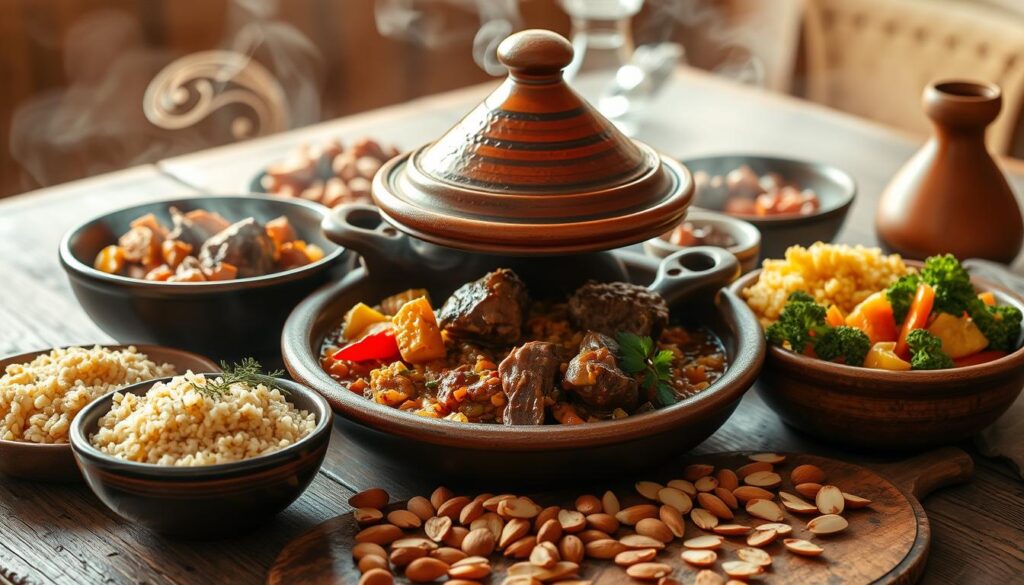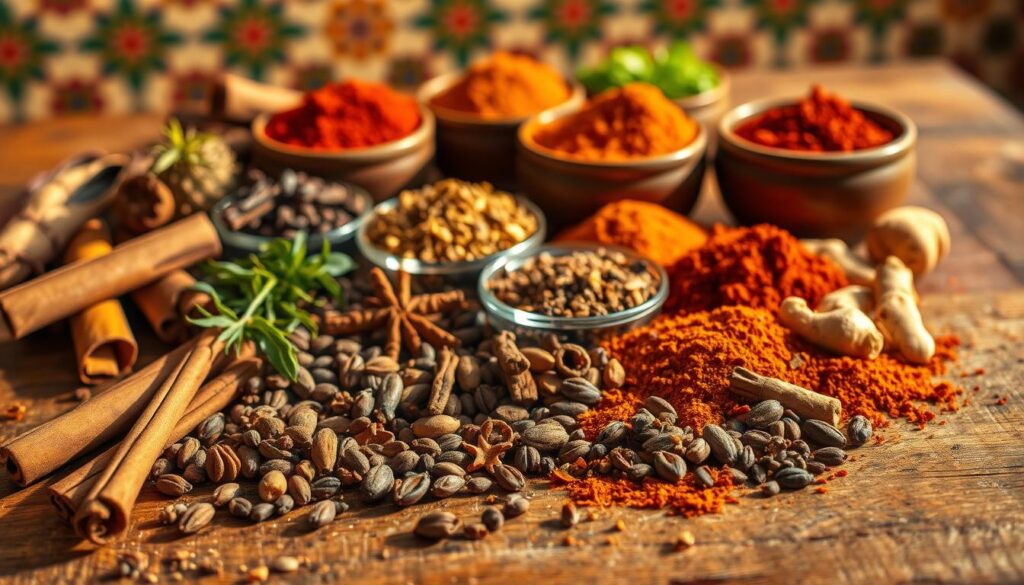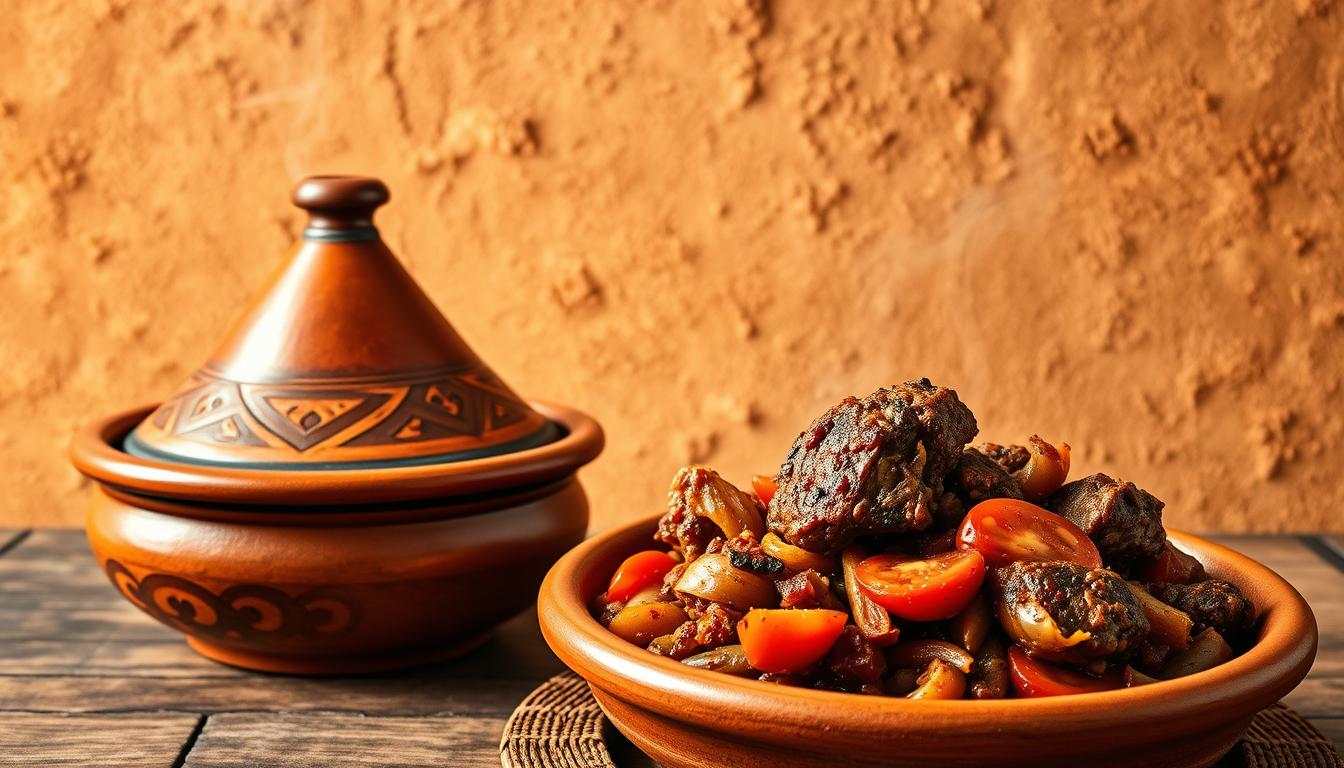Moroccan cuisine
Table of Contents
Moroccan cuisine
Did you know one dish can carry flavors from four continents? From the bustling markets of Marrakech to family kitchens, North Africa’s culinary heartbeat thrives on blending Arab, Berber, and Mediterranean traditions. This fusion creates meals that feel like a passport to ancient trade routes and vibrant cultures.
Imagine savoring tender meat simmered with apricots and almonds in a clay pot. Or fluffy couscous layered with vegetables and spices. These dishes aren’t just meals—they’re stories passed down through generations. Every bite reflects centuries of shared history, from the Atlas Mountains to coastal towns.
What makes these flavors unforgettable? It’s the balance of sweet and savory, heat and warmth. Think saffron, cumin, and cinnamon dancing together. Even the cooking methods, like slow-cooking in a tagine, connect today’s kitchens to ancestral roots.
Ready to explore further? This guide will walk you through iconic recipes, street food gems, and the secrets behind Morocco’s most beloved food. Let’s uncover how every spice, technique, and shared meal invites you to taste a world shaped by travel and tradition.
Key Takeaways
- Blends Arab, Berber, and Mediterranean flavors for a unique taste experience
- Signature dishes like tagine and couscous showcase slow-cooked traditions
- Spices like saffron and cumin create bold, balanced flavors
- Clay pot cooking methods preserve cultural heritage
- Street food and markets offer authentic culinary adventures
- Every meal tells a story of history and regional diversity
Discover the Rich Heritage of Moroccan Cuisine
What if your kitchen tools could whisper stories from 1,000 years ago? Across this sun-drenched country, every spice jar and clay pot holds fragments of history. Ancient trade routes brought saffron from Persia, cumin from India, and citrus from Andalusia—ingredients now inseparable from home cooking.
Ancient Influences and Cultural Traditions
Berber tribes first mastered slow-cooked stews in earthenware pots, locking in moisture and flavor. Arab traders later introduced spices like cinnamon and ginger, creating layered tastes still loved today. “The tagine isn’t just a dish—it’s a time capsule,” says Marrakech chef Amina El Filali. “Each simmer connects us to generations who shaped these recipes.”
Three key elements define this culinary legacy:
| Time Period | Key Ingredients | Cooking Tools | Cultural Influence |
|---|---|---|---|
| Berber Era | Barley, dates | Clay ovens | Nomadic simplicity |
| Andalusian Influence | Almonds, citrus | Ceramic tagines | Royal court refinement |
| Modern Day | Preserved lemons, argan oil | Combination methods | Global fusion |
How History Shapes Today’s Kitchen
You’ll notice historic information in everyday meals. That lamb tagine with prunes? It mirrors medieval sweet-savory pairings. Family recipes often blend Berber preservation techniques with Arab spice blends—proof that tradition evolves without losing its roots.
Modern chefs honor these methods while experimenting. Home cooks still prefer clay cookware for its even heat distribution, bridging past and present. This living history turns every meal into a delicious lesson.
Top Moroccan Dishes You Need to Try
Ever tasted a dish that feels like a warm hug from a thousand-year-old recipe? These iconic meals blend textures and flavors in ways that’ll make your taste buds dance. Let’s explore the stars of North African cooking.
Tajine and Couscous Delights

Picture tender chicken simmered with olives and preserved lemons. Or fall-off-the-bone lamb paired with prunes and toasted almonds. Both shine in clay tagines, where low heat coaxes out deep, layered flavors.
Couscous steals the show too. Fluffy grains soak up broth from veggies like carrots and zucchini. Some versions feature raisins for sweetness or harissa for heat. “The secret?” says Fez home cook Youssef Benali. “Steam the grains three times—patience rewards you.”
| Dish | Main Protein | Signature Flavor | Cooking Time |
|---|---|---|---|
| Chicken Tagine | Chicken thighs | Lemon + olives | 2 hours |
| Lamb Tagine | Lamb shoulder | Prunes + cinnamon | 3 hours |
| Vegetable Couscous | Chickpeas | Carrots + cumin | 1.5 hours |
Sweet and Savory Pastry Traditions
Crave something crispy? Try pastilla—a flaky pie stuffed with spiced pigeon or chicken. Powdered sugar and cinnamon dust the top, creating a “why haven’t I tried this sooner?” moment.
Street vendors sell smaller treats too. Briouats fold ground lamb or seafood into phyllo triangles. Sweet versions drip with honey and crushed almonds. Want to experiment? Start with this easy recipe:
| Pastry | Filling | Texture | Serving Tip |
|---|---|---|---|
| Pastilla | Shredded chicken | Crispy layers | Dust with cinnamon |
| Briouats | Spiced lamb | Crunchy shell | Dip in mint tea |
| Chebakia | Sesame + honey | Sticky petals | Pair with coffee |
Ready to cook? These dishes prove that tradition tastes best when shared. Grab a tagine pot or steamer basket—your kitchen’s about to smell incredible.
Iconic Flavors and Signature Ingredients
What if every spice blend whispered a family secret? The magic lies in balancing bold flavors that dance between sweet, savory, and aromatic. Let’s decode the elements that make these dishes unforgettable.

Essential Spices, Herbs, and Preserved Elements
Imagine cinnamon hugging coriander in a warm embrace. Preserved lemons add zing to tagines, while green olives cut through rich meats. These ingredients aren’t random—they’re carefully paired through generations.
| Ingredient | Flavor Role | Common Pairings |
|---|---|---|
| Cinnamon | Warm sweetness | Lamb, couscous, pastries |
| Coriander | Citrusy depth | Chicken, fish, sauces |
| Preserved Lemon | Tangy brightness | Tagines, salads |
| Almonds | Crunchy contrast | Desserts, rice dishes |
Sauces transform meals. A chermoula marinade blends garlic, paprika, and herbs to elevate grilled fish. “The sauce isn’t just added flavor—it’s the soul of the dish,” notes Casablanca chef Leila Moussa.
Mint Tea and Other Flavorful Beverages
Need a reset between courses? Mint tea does the trick. Fresh spearmint leaves meet gunpowder green tea in a ritual poured from height to aerate the brew.
“Pouring tea isn’t just serving—it’s showing respect. The higher the stream, the warmer the welcome.”
| Beverage | Key Ingredients | Serving Tradition |
|---|---|---|
| Mint Tea | Green tea, mint, sugar | Three pours minimum |
| Avocado Smoothie | Avocado, milk, orange blossom | Street food companion |
| Spiced Coffee | Cardamom, black pepper | After-dinner digestif |
From spice racks to teacups, these elements create harmony in every bite and sip. They prove that great flavor needs both science and storytelling.
Traditional Cooking Techniques and Tools
How do home cooks create meals that taste like history? Time-tested methods turn simple ingredients into unforgettable feasts. Let’s explore two pillars of North African kitchens: slow-cooked stews and daily bread rituals.
Mastering the Art of the Clay Tagine
That cone-shaped lid isn’t just for show. Clay tagines trap steam, letting meat become fork-tender while vegetables soak up spices. Start by layering onions, garlic, and cumin at the base. Add protein, then top with carrots or zucchini. Low heat works magic—expect 3 hours for lamb to absorb saffron-infused broth.
| Ingredient Layer | Function | Pro Tip |
|---|---|---|
| Onions/Garlic | Flavor foundation | Caramelize first |
| Meat (chicken/lamb) | Protein centerpiece | Brown before stewing |
| Vegetables | Texture balance | Add late to prevent mush |
Baking Khobz: Traditional Bread
No meal feels complete without warm, crusty bread. Khobz dough mixes semolina and yeast, then bakes in a wood-fired oven. The secret? Slap the dough onto hot stones for that signature crackle. “It’s not just food—it’s your edible spoon,” laughs Marrakech baker Fatima Zahra.
| Step | Time | Key Action |
|---|---|---|
| Kneading | 15 mins | Develop gluten |
| Rising | 1 hour | Double in size |
| Baking | 20 mins | 500°F stone heat |
Pair khobz with dips or use it to scoop tagines. Store leftovers in cloth—they’ll stay fresh for tomorrow’s feast.
Regional Variations and Influences
Ever wondered why a single country offers such wildly different tastes? Coastal towns and mountain villages use the same spices but create entirely unique experiences. Your palate travels further than you think—without leaving the table.
From Andalusian Influences to Berber Roots
Seaside cities like Essaouira build main dishes around fresh catches. Think sardines grilled with chermoula marinade or octopus salads brightened with lemon. Here, mint grows abundantly, flavoring teas and seafood sauces alike.
Head inland, and hearty stews dominate. Berber communities slow-cook lamb with dried fruits in clay pots. Tomatoes and peppers roast over open flames, adding smoky depth to vegetable tagines. “Our land dictates our plates,” says Chef Hassan from the Atlas Mountains. “Mountains demand warmth. Coasts crave freshness.”
| Region | Main Dishes | Key Ingredients | Cooking Style |
|---|---|---|---|
| Coastal North | Fish tagines | Mint, citrus | Quick grilling |
| Atlas Mountains | Lamb stews | Tomatoes, peppers | Slow braising |
| Sahara Edge | Camel kebabs | Cumin, dates | Open-fire roasting |
Neighboring cultures left marks too. Spanish paprika spices up northern dishes, while Algerian harissa adds heat to eastern recipes. Each area’s flavour fingerprint turns meals into edible maps.
These differences make exploring rewarding. One day you’re crunching fried makouda potato balls in Marrakech. The next, savoring almond-stuffed pigeon pie in Fes. Every region shares its secrets—if you know where to taste.
Moroccan Street Food and Casual Dining Experiences
Imagine biting into crispy potato fritters while musicians play ancient Gnawa rhythms nearby. This is everyday magic at Marrakech’s Djemaa el-Fna square, where sizzling grills perfume the air. Vendors craft foods to try right before your eyes—from golden makouda balls to chermoula-slathered sardines.
Exploring Djemaa el-Fna and Local Markets
Follow the smoke to stalls often served family-style. Skewers of spiced meat vegetables rotate over coals, dripping juices onto charcoal. Don’t miss snail soup simmering in copper pots—locals swear by its digestive powers.
| Must-Try Street Foods | Key Ingredients | Flavor Profile | Best Time to Eat |
|---|---|---|---|
| Makouda | Potatoes, herbs | Crispy + garlicky | Mid-morning snack |
| Chermoula Fish | Sea bream, paprika | Smoky + citrusy | Sunset dinner |
| Msemen | Semolina, honey | Flaky + sweet | Breakfast with tea |
Everyday Treats and Quick Bites
Roadside cafés dish out harira soup ladled into clay bowls. “Our secret?” laughs Fez vendor Rashid. “Add lentils last—keeps them firm.” For dessert, sticky chebakia cookies glisten with sesame honey.
Plan your trip around food carts and hole-in-the-wall restaurants. These spots use ingredients picked at dawn, proving great flavor needs no fancy plating. Every bite feels like joining a centuries-old block party.
Conclusion
Every spoonful tells a story of crossroads and connections. From hearty soups simmered for hours to zesty citrus juices balancing spice-laden dishes, each element serves a purpose. Lentils thicken stews, while saffron-infused broths turn simple bowls into edible art. Even sugar plays dual roles—caramelizing meats and sweetening mint tea.
Special moments like the month of Ramadan showcase this harmony. Families gather around steaming tagines and break fasts with dates dipped in milk. Street vendors craft crispy briouats alongside vendors pouring aromatic tea—a reminder that tradition thrives in every bite.
These flavors hold a unique place in global kitchens because they’re rooted in shared history. Whether you’re recreating a lamb-and-prune tagine or mastering flaky pastilla dough, you’re keeping centuries of craft alive. Grab your clay pot or spice grinder—your next unforgettable meal awaits.








3 Comments